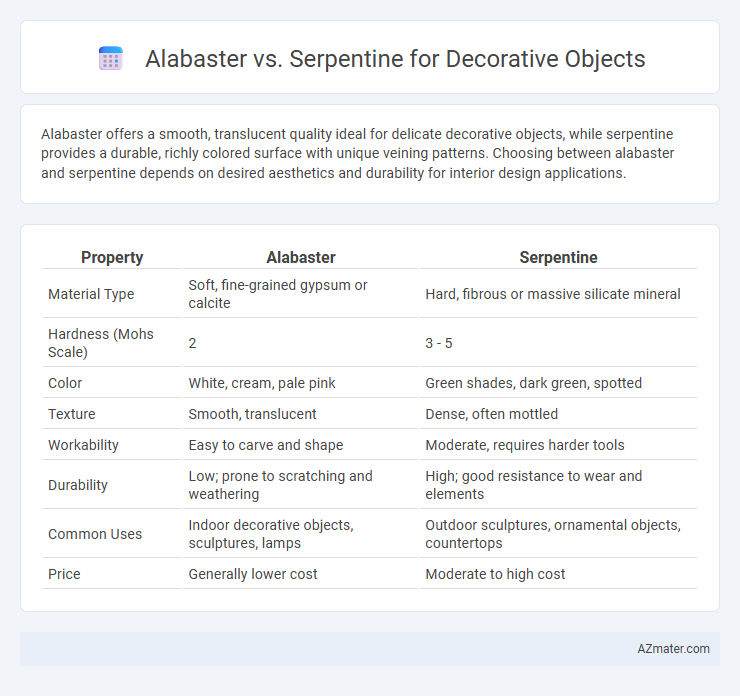Alabaster offers a smooth, translucent quality ideal for delicate decorative objects, while serpentine provides a durable, richly colored surface with unique veining patterns. Choosing between alabaster and serpentine depends on desired aesthetics and durability for interior design applications.
Table of Comparison
| Property | Alabaster | Serpentine |
|---|---|---|
| Material Type | Soft, fine-grained gypsum or calcite | Hard, fibrous or massive silicate mineral |
| Hardness (Mohs Scale) | 2 | 3 - 5 |
| Color | White, cream, pale pink | Green shades, dark green, spotted |
| Texture | Smooth, translucent | Dense, often mottled |
| Workability | Easy to carve and shape | Moderate, requires harder tools |
| Durability | Low; prone to scratching and weathering | High; good resistance to wear and elements |
| Common Uses | Indoor decorative objects, sculptures, lamps | Outdoor sculptures, ornamental objects, countertops |
| Price | Generally lower cost | Moderate to high cost |
Introduction to Alabaster and Serpentine
Alabaster, a fine-grained, translucent form of gypsum or calcite, is prized for its smooth texture and soft white appearance, making it ideal for intricate decorative objects. Serpentine, composed primarily of magnesium silicate minerals, offers a rich palette of green hues and a unique, often veined pattern that enhances ornamental carvings. Both materials are valued for their workability and aesthetic qualities, but alabaster's delicate translucency contrasts sharply with serpentine's durable, natural stone look.
Geological Origins and Composition
Alabaster originates from fine-grained gypsum or calcite deposits, characterized by its soft texture and translucent white to cream coloration, making it ideal for delicate decorative objects. Serpentine is a group of greenish, metamorphic minerals rich in magnesium silicate, distinguished by its varied patterns and hardness suitable for intricate carvings. The geological origins influence their physical properties: alabaster forms from sedimentary evaporite deposits while serpentine derives from the alteration of ultramafic rocks in tectonic settings.
Visual Appearance and Color Variations
Alabaster features a translucent, milky white to creamy beige appearance, often exhibiting subtle veining that enhances its soft, elegant look ideal for luminous decorative objects. Serpentine offers a more varied color palette, ranging from deep green and olive tones to mottled patterns with yellow, black, or white accents, adding a rich, earthy aesthetic perfect for bold statement pieces. The smooth, almost waxy finish of alabaster contrasts with serpentine's typically speckled or veined texture, making each material visually distinct for different artistic styles.
Workability and Carving Differences
Alabaster offers superior workability compared to serpentine due to its softer, fine-grained texture, making it ideal for intricate decorative carving and detailed finishes. Serpentine is harder and more brittle, requiring specialized tools and skill to carve, which can limit the level of detail achievable in decorative objects. Choosing alabaster allows for smoother sculpting processes and finer detailing, whereas serpentine is favored for polished surfaces and durability in decorative art.
Durability and Longevity
Alabaster offers a smooth, translucent appearance but is relatively soft, rating around 3 to 4 on the Mohs hardness scale, making it prone to scratching and damage over time in decorative objects. Serpentine, with a hardness of approximately 3 to 6 depending on the variety, provides better resistance to wear and minor impacts, contributing to greater durability and longevity for ornamental uses. For decorative objects requiring long-lasting appeal and durability, serpentine stands out as a more resilient choice compared to the more fragile alabaster.
Maintenance and Care Requirements
Alabaster requires gentle handling and regular dusting with a soft, dry cloth to prevent scratching and damage, as it is a softer, more porous material prone to staining and moisture absorption. Serpentine, being a harder and more durable stone, demands less frequent maintenance and is more resistant to chipping and moisture, but it should still be cleaned with mild soap and water to preserve its polished finish. Both materials benefit from avoiding harsh chemicals and sudden temperature changes to maintain their aesthetic appeal and structural integrity over time.
Popular Uses in Decorative Objects
Alabaster is widely favored in decorative objects for its smooth texture and translucency, making it ideal for intricate sculptures, lamps, and vases that require delicate detail and a soft glow. Serpentine is popular in decorative use for its rich green hues and unique marbling, often shaped into ornamental bowls, figurines, and tabletops that highlight its natural patterns and durability. Both materials are chosen for their aesthetic appeal, with alabaster excelling in light-enhancing pieces and serpentine prized for its vibrant color and resilience.
Price and Availability Comparison
Alabaster is generally more expensive than serpentine due to its rarity and fine, translucent quality, making it a premium choice for decorative objects. Serpentine is widely available and more affordable, favored for its range of green hues and easier sourcing from multiple global locations. Collectors and artisans often choose alabaster when cost is less of a concern and aesthetic delicacy is prioritized, while serpentine suits budget-conscious buyers seeking earthy, polished finishes.
Environmental Impact and Sustainability
Alabaster, a soft sulfate mineral primarily composed of gypsum, is often preferred for decorative objects due to its low environmental impact, as it is abundant and requires less energy-intensive extraction and processing compared to serpentine, a harder magnesium iron silicate mineral. Serpentine mining can lead to greater ecological disruption and emissions because of its hardness and the complex extraction techniques involved, raising concerns about its sustainability. Choosing alabaster supports more sustainable artisanal practices with lower carbon footprints, making it a more environmentally friendly option for decorative use.
Choosing the Right Stone for Your Decor
Choosing alabaster or serpentine for decorative objects depends on your desired aesthetic and durability. Alabaster offers a smooth, translucent appearance ideal for intricate carvings and soft lighting effects, while serpentine provides a rich green color and greater hardness, making it more resistant to scratches and suitable for high-traffic areas. Consider alabaster for elegant, delicate decor and serpentine for a bold, long-lasting statement piece.

Infographic: Alabaster vs Serpentine for Decorative Object
 azmater.com
azmater.com